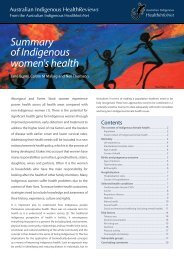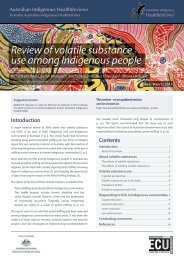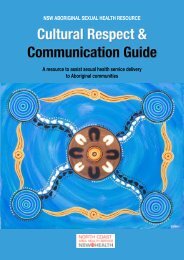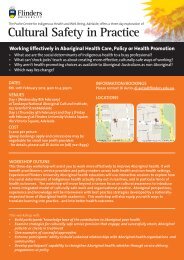hearing loss and the criminal justice system - Australian Indigenous ...
hearing loss and the criminal justice system - Australian Indigenous ...
hearing loss and the criminal justice system - Australian Indigenous ...
Create successful ePaper yourself
Turn your PDF publications into a flip-book with our unique Google optimized e-Paper software.
Senate Inquiry March 2010_________________________________________________________________________________________________________________INSTITUTIONAL RESPONSIVENESSWhile <strong>the</strong> research highlights what can work, <strong>the</strong>re remain many problems in developing<strong>and</strong> implementing such programs. As Partington et al. (1999) describe, <strong>the</strong>re are powerfulinstitutional pressures that inhibit <strong>the</strong> intent of individual teachers to adapt classrooms sothat <strong>the</strong> overall classroom environment is more responsive to <strong>the</strong> needs of <strong>Indigenous</strong>students.The Quality Schools for <strong>Indigenous</strong> Students Project (Partington et al, 1999) identifiedseveral institutional obstacles to schools being responsive to <strong>the</strong> special needs of <strong>Indigenous</strong>students, <strong>and</strong> <strong>the</strong>ir review of <strong>the</strong> literature found that schools <strong>and</strong> teachers can be at <strong>the</strong>forefront of problems in <strong>Indigenous</strong> education (Harrison, Partington, Harslett, Godfrey &Richer, 2000). Factors identified include: Problems in teacher pedagogy; Low teacher expectations of <strong>Indigenous</strong> students; Negative attitudes among teachers arising from stereotyping <strong>Indigenous</strong>students as deficient <strong>and</strong>/or disinterested; Stereotyping, by teachers, of <strong>Indigenous</strong> students as being obstructive; Inadequate communication <strong>and</strong> public relations between <strong>the</strong> schooladministration <strong>and</strong> <strong>the</strong> home.Partington et al. (1999) concluded that without a cohesive school approach, individualteachers were unable to change things. Institutional factors also contributed to poor use of<strong>Indigenous</strong> staff in schools. Partington et al. (1999) found <strong>the</strong> subordinate role expected of<strong>Indigenous</strong> staff, engendered conservatism in educational practice, <strong>and</strong> <strong>the</strong> authorsindicated that non‐<strong>Indigenous</strong> teachers need to gain perspectives that empower <strong>Indigenous</strong>staff.<strong>Indigenous</strong> teachers suffer from an institutionalised disempowerment, which is oftenclo<strong>the</strong>d in ethnocentric assumptions about teacher professionalism. This results in<strong>Indigenous</strong> teachers becoming frustrated because <strong>the</strong>y are prevented from teaching <strong>and</strong>interacting with <strong>Indigenous</strong> students in <strong>the</strong> way <strong>the</strong>y wish. Too often <strong>Indigenous</strong> staff arerecruited to schools only to be marginalised within <strong>the</strong> school, have <strong>the</strong>ir expertise ignoredor be used as an aid to ensuring student compliance (Buckskin & Hignett, 1994; Harslett,Harrison, Godfrey, Partington & Richer 1998; Harris & Malin, 1994).One example of this is <strong>the</strong> experience of two <strong>Indigenous</strong> teachers in Darwin. One describedhow she was criticised for being ‘too friendly’ with <strong>Indigenous</strong> students on <strong>the</strong> playground,because it created <strong>the</strong> expectation that o<strong>the</strong>r teachers should be equally friendly. The o<strong>the</strong>r<strong>Indigenous</strong> teacher reported that she was criticised for establishing what she considered acomfortable setting for interviews with <strong>Indigenous</strong> parents. It was suggested that if she wastoo friendly, <strong>the</strong>n parents would not respect her (personal communication).Heslop (1998) outlined how assimilationist assumptions also limit <strong>the</strong> ability of <strong>the</strong> parentsof <strong>Indigenous</strong> students to effectively exert any control in <strong>the</strong>ir children’s schools. Becauseschool administrations operate in a Western style, a Western style of interaction is requiredwhen dealing <strong>the</strong>m. Thus, <strong>Indigenous</strong> parents are effectively prevented from exerting anyreal control in <strong>the</strong>ir children’s education (Ngarritjan‐Kessaris, 1994). The ways parents are_________________________________________________________________________________________________________________33 Phoenix Consulting








